Bowen Zheng
A Hybrid Early-Exit Algorithm for Large Language Models Based on Space Alignment Decoding (SPADE)
Jul 23, 2025Abstract:Large language models are computationally expensive due to their deep structures. Prior research has shown that intermediate layers contain sufficient information to generate accurate answers, leading to the development of early-exit algorithms that reduce inference costs by terminating computation at earlier layers. However, these methods often suffer from poor performance due to misalignment between intermediate and output layer representations that lead to decoding inaccuracy. To address these challenges, we propose SPADE (SPace Alignment DEcoding), a novel decoding method that aligns intermediate layer representations with the output layer by propagating a minimally reduced sequence consisting of only the start token and the answer token. We further optimize the early-exit decision-making process by training a linear approximation of SPADE that computes entropy-based confidence metrics. Putting them together, we create a hybrid early-exit algorithm that monitors confidence levels and stops inference at intermediate layers while using SPADE to generate high-quality outputs. This approach significantly reduces inference costs without compromising accuracy, offering a scalable and efficient solution for deploying large language models in real-world applications.
Integrated Pipeline for Monocular 3D Reconstruction and Finite Element Simulation in Industrial Applications
Jun 16, 2025Abstract:To address the challenges of 3D modeling and structural simulation in industrial environment, such as the difficulty of equipment deployment, and the difficulty of balancing accuracy and real-time performance, this paper proposes an integrated workflow, which integrates high-fidelity 3D reconstruction based on monocular video, finite element simulation analysis, and mixed reality visual display, aiming to build an interactive digital twin system for industrial inspection, equipment maintenance and other scenes. Firstly, the Neuralangelo algorithm based on deep learning is used to reconstruct the 3D mesh model with rich details from the surround-shot video. Then, the QuadRemesh tool of Rhino is used to optimize the initial triangular mesh and generate a structured mesh suitable for finite element analysis. The optimized mesh is further discretized by HyperMesh, and the material parameter setting and stress simulation are carried out in Abaqus to obtain high-precision stress and deformation results. Finally, combined with Unity and Vuforia engine, the real-time superposition and interactive operation of simulation results in the augmented reality environment are realized, which improves users 'intuitive understanding of structural response. Experiments show that the method has good simulation efficiency and visualization effect while maintaining high geometric accuracy. It provides a practical solution for digital modeling, mechanical analysis and interactive display in complex industrial scenes, and lays a foundation for the deep integration of digital twin and mixed reality technology in industrial applications.
Revisiting Diffusion Models: From Generative Pre-training to One-Step Generation
Jun 11, 2025Abstract:Diffusion distillation is a widely used technique to reduce the sampling cost of diffusion models, yet it often requires extensive training, and the student performance tends to be degraded. Recent studies show that incorporating a GAN objective may alleviate these issues, yet the underlying mechanism remains unclear. In this work, we first identify a key limitation of distillation: mismatched step sizes and parameter numbers between the teacher and the student model lead them to converge to different local minima, rendering direct imitation suboptimal. We further demonstrate that a standalone GAN objective, without relying a distillation loss, overcomes this limitation and is sufficient to convert diffusion models into efficient one-step generators. Based on this finding, we propose that diffusion training may be viewed as a form of generative pre-training, equipping models with capabilities that can be unlocked through lightweight GAN fine-tuning. Supporting this view, we create a one-step generation model by fine-tuning a pre-trained model with 85% of parameters frozen, achieving strong performance with only 0.2M images and near-SOTA results with 5M images. We further present a frequency-domain analysis that may explain the one-step generative capability gained in diffusion training. Overall, our work provides a new perspective for diffusion training, highlighting its role as a powerful generative pre-training process, which can be the basis for building efficient one-step generation models.
Minute-Long Videos with Dual Parallelisms
May 29, 2025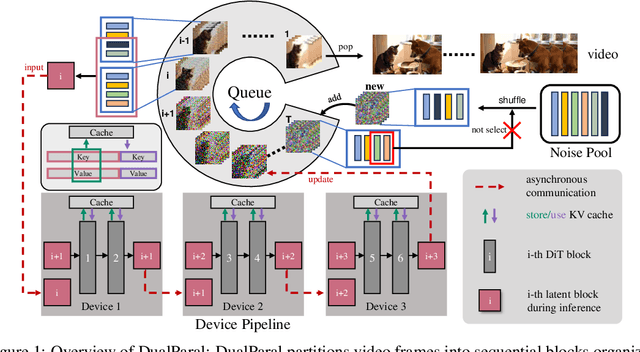


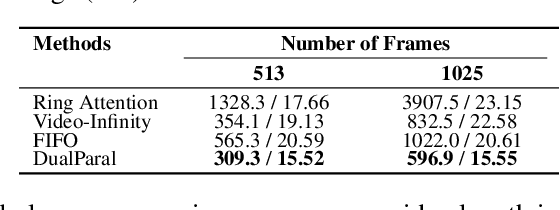
Abstract:Diffusion Transformer (DiT)-based video diffusion models generate high-quality videos at scale but incur prohibitive processing latency and memory costs for long videos. To address this, we propose a novel distributed inference strategy, termed DualParal. The core idea is that, instead of generating an entire video on a single GPU, we parallelize both temporal frames and model layers across GPUs. However, a naive implementation of this division faces a key limitation: since diffusion models require synchronized noise levels across frames, this implementation leads to the serialization of original parallelisms. We leverage a block-wise denoising scheme to handle this. Namely, we process a sequence of frame blocks through the pipeline with progressively decreasing noise levels. Each GPU handles a specific block and layer subset while passing previous results to the next GPU, enabling asynchronous computation and communication. To further optimize performance, we incorporate two key enhancements. Firstly, a feature cache is implemented on each GPU to store and reuse features from the prior block as context, minimizing inter-GPU communication and redundant computation. Secondly, we employ a coordinated noise initialization strategy, ensuring globally consistent temporal dynamics by sharing initial noise patterns across GPUs without extra resource costs. Together, these enable fast, artifact-free, and infinitely long video generation. Applied to the latest diffusion transformer video generator, our method efficiently produces 1,025-frame videos with up to 6.54$\times$ lower latency and 1.48$\times$ lower memory cost on 8$\times$RTX 4090 GPUs.
LARES: Latent Reasoning for Sequential Recommendation
May 22, 2025Abstract:Sequential recommender systems have become increasingly important in real-world applications that model user behavior sequences to predict their preferences. However, existing sequential recommendation methods predominantly rely on non-reasoning paradigms, which may limit the model's computational capacity and result in suboptimal recommendation performance. To address these limitations, we present LARES, a novel and scalable LAtent REasoning framework for Sequential recommendation that enhances model's representation capabilities through increasing the computation density of parameters by depth-recurrent latent reasoning. Our proposed approach employs a recurrent architecture that allows flexible expansion of reasoning depth without increasing parameter complexity, thereby effectively capturing dynamic and intricate user interest patterns. A key difference of LARES lies in refining all input tokens at each implicit reasoning step to improve the computation utilization. To fully unlock the model's reasoning potential, we design a two-phase training strategy: (1) Self-supervised pre-training (SPT) with dual alignment objectives; (2) Reinforcement post-training (RPT). During the first phase, we introduce trajectory-level alignment and step-level alignment objectives, which enable the model to learn recommendation-oriented latent reasoning patterns without requiring supplementary annotated data. The subsequent phase utilizes reinforcement learning (RL) to harness the model's exploratory ability, further refining its reasoning capabilities. Comprehensive experiments on real-world benchmarks demonstrate our framework's superior performance. Notably, LARES exhibits seamless compatibility with existing advanced models, further improving their recommendation performance.
DeepRec: Towards a Deep Dive Into the Item Space with Large Language Model Based Recommendation
May 22, 2025Abstract:Recently, large language models (LLMs) have been introduced into recommender systems (RSs), either to enhance traditional recommendation models (TRMs) or serve as recommendation backbones. However, existing LLM-based RSs often do not fully exploit the complementary advantages of LLMs (e.g., world knowledge and reasoning) and TRMs (e.g., recommendation-specific knowledge and efficiency) to fully explore the item space. To address this, we propose DeepRec, a novel LLM-based RS that enables autonomous multi-turn interactions between LLMs and TRMs for deep exploration of the item space. In each interaction turn, LLMs reason over user preferences and interact with TRMs to retrieve candidate items. After multi-turn interactions, LLMs rank the retrieved items to generate the final recommendations. We adopt reinforcement learning(RL) based optimization and propose novel designs from three aspects: recommendation model based data rollout, recommendation-oriented hierarchical rewards, and a two-stage RL training strategy. For data rollout, we introduce a preference-aware TRM, with which LLMs interact to construct trajectory data. For rewards, we design a hierarchical reward function that involves both process-level and outcome-level rewards to optimize the interaction process and recommendation performance, respectively. For RL training, we develop a two-stage training strategy, where the first stage aims to guide LLMs to interact with TRMs and the second stage focuses on performance improvement. Experiments on public datasets demonstrate that DeepRec significantly outperforms both traditional and LLM-based baselines, offering a new paradigm for deep exploration in recommendation systems.
Universal Item Tokenization for Transferable Generative Recommendation
Apr 06, 2025

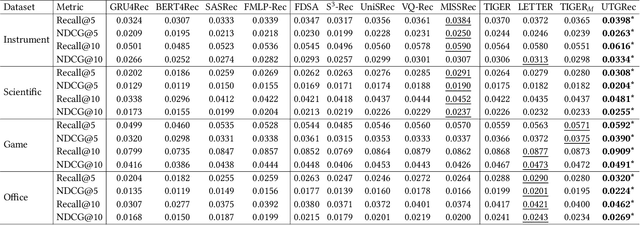
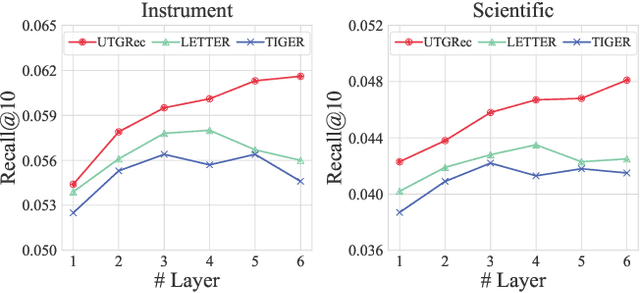
Abstract:Recently, generative recommendation has emerged as a promising paradigm, attracting significant research attention. The basic framework involves an item tokenizer, which represents each item as a sequence of codes serving as its identifier, and a generative recommender that predicts the next item by autoregressively generating the target item identifier. However, in existing methods, both the tokenizer and the recommender are typically domain-specific, limiting their ability for effective transfer or adaptation to new domains. To this end, we propose UTGRec, a Universal item Tokenization approach for transferable Generative Recommendation. Specifically, we design a universal item tokenizer for encoding rich item semantics by adapting a multimodal large language model (MLLM). By devising tree-structured codebooks, we discretize content representations into corresponding codes for item tokenization. To effectively learn the universal item tokenizer on multiple domains, we introduce two key techniques in our approach. For raw content reconstruction, we employ dual lightweight decoders to reconstruct item text and images from discrete representations to capture general knowledge embedded in the content. For collaborative knowledge integration, we assume that co-occurring items are similar and integrate collaborative signals through co-occurrence alignment and reconstruction. Finally, we present a joint learning framework to pre-train and adapt the transferable generative recommender across multiple domains. Extensive experiments on four public datasets demonstrate the superiority of UTGRec compared to both traditional and generative recommendation baselines.
Pre-training Generative Recommender with Multi-Identifier Item Tokenization
Apr 06, 2025Abstract:Generative recommendation autoregressively generates item identifiers to recommend potential items. Existing methods typically adopt a one-to-one mapping strategy, where each item is represented by a single identifier. However, this scheme poses issues, such as suboptimal semantic modeling for low-frequency items and limited diversity in token sequence data. To overcome these limitations, we propose MTGRec, which leverages Multi-identifier item Tokenization to augment token sequence data for Generative Recommender pre-training. Our approach involves two key innovations: multi-identifier item tokenization and curriculum recommender pre-training. For multi-identifier item tokenization, we leverage the RQ-VAE as the tokenizer backbone and treat model checkpoints from adjacent training epochs as semantically relevant tokenizers. This allows each item to be associated with multiple identifiers, enabling a single user interaction sequence to be converted into several token sequences as different data groups. For curriculum recommender pre-training, we introduce a curriculum learning scheme guided by data influence estimation, dynamically adjusting the sampling probability of each data group during recommender pre-training. After pre-training, we fine-tune the model using a single tokenizer to ensure accurate item identification for recommendation. Extensive experiments on three public benchmark datasets demonstrate that MTGRec significantly outperforms both traditional and generative recommendation baselines in terms of effectiveness and scalability.
Bridging Textual-Collaborative Gap through Semantic Codes for Sequential Recommendation
Mar 15, 2025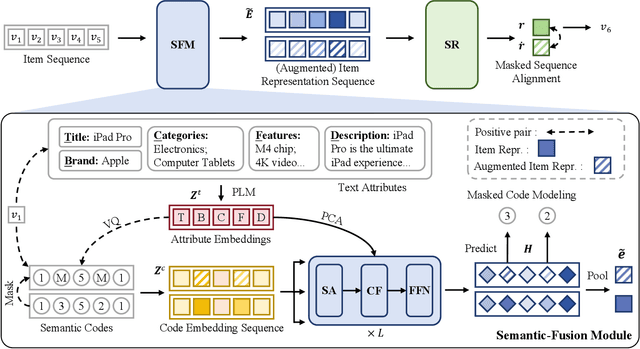



Abstract:In recent years, substantial research efforts have been devoted to enhancing sequential recommender systems by integrating abundant side information with ID-based collaborative information. This study specifically focuses on leveraging the textual metadata (e.g., titles and brands) associated with items. While existing methods have achieved notable success by combining text and ID representations, they often struggle to strike a balance between textual information embedded in text representations and collaborative information from sequential patterns of user behavior. In light of this, we propose CoCoRec, a novel Code-based textual and Collaborative semantic fusion method for sequential Recommendation. The key idea behind our approach is to bridge the gap between textual and collaborative information using semantic codes. Specifically, we generate fine-grained semantic codes from multi-view text embeddings through vector quantization techniques. Subsequently, we develop a code-guided semantic-fusion module based on the cross-attention mechanism to flexibly extract and integrate relevant information from text representations. In order to further enhance the fusion of textual and collaborative semantics, we introduce an optimization strategy that employs code masking with two specific objectives: masked code modeling and masked sequence alignment. The merit of these objectives lies in leveraging mask prediction tasks and augmented item representations to capture code correlations within individual items and enhance the sequence modeling of the recommendation backbone. Extensive experiments conducted on four public datasets demonstrate the superiority of CoCoRec, showing significant improvements over various sequential recommendation models. Our code is available at https://anonymous.4open.science/r/CoCoRec-6E41.
Straight-Line Diffusion Model for Efficient 3D Molecular Generation
Mar 04, 2025Abstract:Diffusion-based models have shown great promise in molecular generation but often require a large number of sampling steps to generate valid samples. In this paper, we introduce a novel Straight-Line Diffusion Model (SLDM) to tackle this problem, by formulating the diffusion process to follow a linear trajectory. The proposed process aligns well with the noise sensitivity characteristic of molecular structures and uniformly distributes reconstruction effort across the generative process, thus enhancing learning efficiency and efficacy. Consequently, SLDM achieves state-of-the-art performance on 3D molecule generation benchmarks, delivering a 100-fold improvement in sampling efficiency. Furthermore, experiments on toy data and image generation tasks validate the generality and robustness of SLDM, showcasing its potential across diverse generative modeling domains.
 Add to Chrome
Add to Chrome Add to Firefox
Add to Firefox Add to Edge
Add to Edge